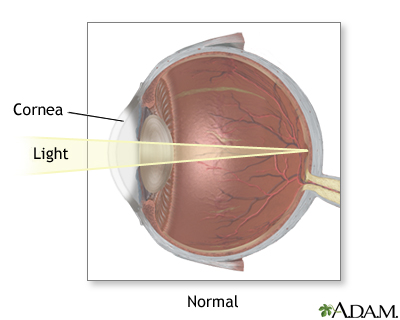Health Library
Refraction
Eye exam - refraction; Vision test - refraction; Refraction
A refraction is an eye exam that measures a person's prescription for eyeglasses or contact lenses.
Images

I Would Like to Learn About:
How the Test is Performed
This test is performed by an ophthalmologist or optometrist. Both of these professionals are often called an "eye doctor."
You sit in a chair that has a special device (called a phoroptor or refractor) attached to it. You look through the device and focus on an eye chart 20 feet (6 meters) away. The device contains lenses of different strengths that can be moved into your view. The test is performed one eye at a time.
- The eye doctor will then ask if the chart appears more or less clear when different lenses are in place.The results depend on your responses.
- Then, a device shines specialized light into your eyes and also determines your refraction. Responses from you are not needed. Each type of refraction has their own benefits.
How to Prepare for the Test
If you wear contact lenses, ask the doctor if you need to remove them and for how long before the test.
How the Test will Feel
There is no discomfort.
Why the Test is Performed
This test can be done as part of a routine eye exam. The purpose is to determine whether you have a refractive error (a need for glasses or contact lenses).
For people over age 40 who have normal distance vision but difficulty with near vision, a refraction test can determine the right power of reading glasses.
Normal Results
If your uncorrected vision (without glasses or contact lenses) is normal, then the refractive error is zero (plano) and your vision should be 20/20 (6/6).
A value of 20/20 (6/6) is normal vision. This means you can read 3/8-inch (1 centimeter) tall letters at 20 feet (6 meters). A small type size is also used to determine normal near vision.
What Abnormal Results Mean
You have a refractive error if you need a combination of lenses to see 20/20 (6/6). Glasses or contact lenses should give you good vision. If you have a refractive error, you have a "prescription." Your prescription is a series of numbers that describe the powers of the lenses needed to make you see clearly.
If your final vision is less than 20/20 (6/6), even with lenses, then there is probably another, non-optical problem with your eye.
The vision level you achieve during the refraction test is called the best-corrected visual acuity (BCVA).
Abnormal results may be due to:
- Astigmatism (abnormally curved cornea causing blurred vision)
- Hyperopia (farsightedness)
- Myopia (nearsightedness)
- Presbyopia (inability to focus on near objects that develops with age)
Other conditions under which the test may be performed:
- Corneal ulcers and infections
- Loss of sharp vision due to macular degeneration
- Retinal detachment (separation of the light-sensitive membrane (retina) in the back of the eye from its supporting layers)
- Retinal vessel occlusion (blockage in a small artery that carries blood to the retina)
- Retinitis pigmentosa (an inherited disorder of the retina)
Risks
There are no risks with this test.
Considerations
You should have a complete eye examination every 3 to 5 years if you have no problems. If your vision becomes blurry, worsens, or if there are other noticeable changes, schedule an exam right away.
After age 40 (or for people with a family history of glaucoma), eye exams should be scheduled at least once a year to test for glaucoma. Anyone with diabetes should also have an eye exam at least once a year or as recommended by their provider.
People with a refractive error should have an eye exam every 1 to 2 years, or when their vision changes.
Related Information
Vision problemsCorneal ulcers and infections
Age-related macular degeneration
Retinal detachment
Retinal artery occlusion
Retinitis pigmentosa
References
Chuck RS, Dunn SP, Flaxel CJ; American Academy of Ophthalmology Preferred Practice Pattern Committee, et al. Comprehensive adult medical eye evaluation preferred practice pattern. Ophthalmology. 2021;128(1):1-29. www.aaojournal.org/article/S0161-6420(20)31026-5/fulltext. Published November 12, 2020.
Jacobs DS, Afshari NA, Bishop RJ, et al. Refractive errors preferred practice pattern. Ophthalmology. 2023;130(3):P1-P60. PMID: 36543603 pubmed.ncbi.nlm.nih.gov/36543603/.
Jacobs DS, Lee JK, Shen TT, et al. Refractive surgery preferred practice pattern. Ophthalmology. 2023;130(3):P61-P135. PMID: 36543604 pubmed.ncbi.nlm.nih.gov/36543604/.
Wu A. Clinical refraction. In: Yanoff M, Duker JS, eds. Ophthalmology. 6th ed. Philadelphia, PA: Elsevier; 2023:chap 2.3.
BACK TO TOPReview Date: 2/12/2023
Reviewed By: Franklin W. Lusby, MD, Ophthalmologist, Lusby Vision Institute, La Jolla, CA. Also reviewed by David C. Dugdale, MD, Medical Director, Brenda Conaway, Editorial Director, and the A.D.A.M. Editorial team.
 | A.D.A.M., Inc. is accredited by URAC, for Health Content Provider (www.urac.org). URAC's accreditation program is an independent audit to verify that A.D.A.M. follows rigorous standards of quality and accountability. A.D.A.M. is among the first to achieve this important distinction for online health information and services. Learn more about A.D.A.M.'s editorial policy, editorial process and privacy policy. A.D.A.M. is also a founding member of Hi-Ethics. This site complies with the HONcode standard for trustworthy health information: verify here. |
The information provided herein should not be used during any medical emergency or for the diagnosis or treatment of any medical condition. A licensed medical professional should be consulted for diagnosis and treatment of any and all medical conditions. Links to other sites are provided for information only -- they do not constitute endorsements of those other sites. No warranty of any kind, either expressed or implied, is made as to the accuracy, reliability, timeliness, or correctness of any translations made by a third-party service of the information provided herein into any other language. © 1997- 2024 A.D.A.M., a business unit of Ebix, Inc. Any duplication or distribution of the information contained herein is strictly prohibited.
